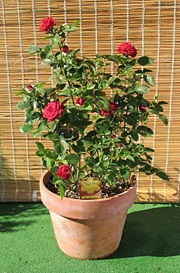Tags: Growing Roses
Secrets To Growing The Best Roses
It has been said that, in order to seduce Mark Anthony, Cleopatra welcomed him to her chamber with her chamber floor covered a foot deep in rose petals. She also soaked the sails of her ship with rose water to perfume the breeze that propelled her. She certainly had a feel for the dramatic and she understood the little secrets, the extras, which promote the ordinary to the spectacular.
If you cultivate roses, you understand the basics. The need for sunlight and a rich, well drained soil, together with careful tending and a healthy, organic rose bed management program. But what promotes the ordinary to the spectacular? How do we turn heads and make our roses the “best on the block”?
Here are five “secrets” to even greater roses.
1. Slow Release Fertilizer.
Nurserymen and growers have been using slow release fertilizer for years for several very good reasons. One application provides the correct nutrients to the rose bush throughout the season and it’s so time-saving. You can buy slow release fertilizer such as “Osmacote”, in most garden stores. It looks like tiny balls of clay coated with a water soluble outer skin. When mixed with soil and water the skin dissolves and the fertilizer starts to work…slowly. This then provides the required nutrients for up to five months. Great for container roses where only a tablespoonful or so would be required, to full size bushes where a handful would be appropriate…….once only, in early spring. No more hit and miss fertilizing, and mid season “blahs” when you suddenly decide your rose bushes need a boost.
2. Finger Pruning.
A simple procedure that is guaranteed to improve the look of your bushes and increase the size of the blooms and all you need is a pair of garden gloves…..actually I don’t even use those! The process is simple. As buds appear on stems, you will notice which direction they are going to send out the new growth. If it’s going to be a new stem that cuts horizontally across the centre of the bush, rub it off with your thumb. This keeps the open, vase shape of the bush. Keep the outward growing and remove the inward. The other thing to do is remove unwanted baby buds. This is particularly true with Tea roses or Floribundas. Often the early baby buds are overcrowded and growing into each other. Remove a few and let those that remain grow even bigger…..and always remove the centre one, as it matures first and you end up with a dead bloom in the centre of four or five half opened ones. Do this when the buds are new, green and soft enough to pinch out.
3. Dead-Heading.
Everyone knows this one but few people do it! Removing the dead blooms in a timely fashion not only makes the bush look good but it promotes more blooms. Leaving them on, acts as a signal to the bush that the end of the blooming season has arrived, and the production of hips is to start. You don’t want this to happen until the fall, so remove the dying blooms. Cut them just below the head, without removing any leaves which the bush needs. Then when the stem has lost all it’s blooms, take it down to the next new growth point, at about a short arms length….and make sure the new growth point is pointing outwards. Cut at an outward angle and this will promote new growth from just below the cut.
4. Liquid Organic Fertilizer.
Every two weeks you should apply a weak solution of organic liquid fertilizer, especially if your roses are in containers. In my area, liquid fish fertilizer is readily available, but whatever may be available in your area, use it at half strength. Check the label carefully and use at half the recommended dosage! Heavy watering and rain wash nutrients through the soil so they have to be replaced and this includes foliar feeding. Most roses enjoy a drenching of weak liquid organic fertilizer to keep them fresh and healthy.
5. Water, Water and Water.
Did I mention water? The magic ingredient to rose show quality blooms. Water long and deeply two or thee times a week unless your roses are in containers, then you need to water daily.
Remember the general rule: watering a rose bed for one hour soaks to a depth of 1 inch! If you can install under-bed soaker hoses so much the better. If you water overhead do it in the morning so the leaves can dry in the heat of the mid-day sun.
Water, Water and Water… someone told me that roses don’t have mouths so they have to drink the nutrients in the soil. If you don’t water, your roses don’t stand a chance of being “the best on the block”.


